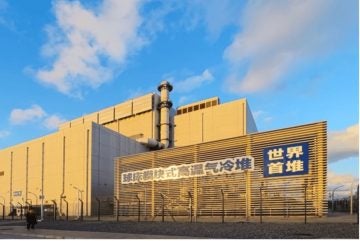
China’s Tsinghua University has demonstrated the inherent safety of China’s HTR-PM commercial pebble-bed NPP by shutting off the power and letting the passive systems maintain control of the reactor core. The experiment was detailed in Joule Volume 8, ISSUE dated 17 July.
Pressurized water reactors (PWRs) require positive steps to shut them down in an emergency and safety systems require a power source to run the pumps that circulate coolants. However, Generation IV reactors like the Shidao Bay NPP high-temperature gas-cooled (HTGR) pebble-bed reactor are designed to be inherently safe. Instead of fuel rods cooled by circulating water inside a pressure vessel, a pebble-bed reactor is essentially a big unpressurised hopper filled with spherical pebbles made of layers of enriched uranium fuel, carbon that acts as a moderator, and silicon carbide coating. In addition, the coolant is helium gas, which is chemically neutral and always remains a gas under all temperatures outside the cryogenic realm.
The fuel pebbles can withstand temperatures of up to 1,600°C (3,000°F), although the reactor core cannot achieve that level. Heat from the pebbles causes the helium to circulate naturally when the pumps are turned off and the high surface-to-volume ratio of the pebbles means heat loss exceeds heat generation.
In addition, the reactor is self-regulating when it comes to the nuclear reaction. When the reactor temperature rises, the atoms in the fuel move faster, creating an effect called Doppler broadening where the neutrons move at different speeds. This means the fuel will absorb more fast neutrons, leaving fewer to sustain the reaction. The higher the temperature, the more the reaction is muted.
In the Shidao Bay test, the two pebble-bed reactors connected to a 210-MWe steam turbine moderated their own nuclear reactions and safe temperatures were maintained, with the core shutting down in minutes. Both reaction and temperature stabilised in about 35 hours. In addition, there was no deterioration of the nuclear fuel.






